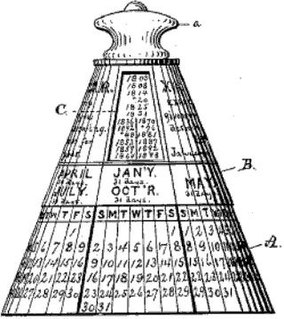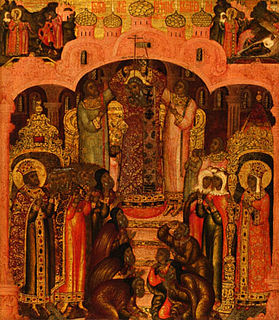A fixed feast is an annual celebration that is held on the same calendar date every year, such as Christmas, as distinguished from moveable feasts, such as Easter, whose calendar date varies.
A fixed feast is an annual celebration that is held on the same calendar date every year, such as Christmas, as distinguished from moveable feasts, such as Easter, whose calendar date varies.

Easter, also called Pascha or Resurrection Sunday, is a Christian festival and cultural holiday commemorating the resurrection of Jesus from the dead, described in the New Testament as having occurred on the third day of his burial following his crucifixion by the Romans at Calvary c. 30 AD. It is the culmination of the Passion of Jesus Christ, preceded by Lent, a 40-day period of fasting, prayer, and penance.
A leap year is a calendar year that contains an additional day added to keep the calendar year synchronized with the astronomical year or seasonal year. Because astronomical events and seasons do not repeat in a whole number of days, calendars that have a constant number of days in each year will unavoidably drift over time with respect to the event that the year is supposed to track, such as seasons. By inserting an additional day or month into some years, the drift between a civilization's dating system and the physical properties of the Solar System can be corrected. A year that is not a leap year is a common year.
A moveable feast is an observance in a Christian liturgical calendar which occurs on different dates in different years.

New Year is the time or day currently at which a new calendar year begins and the calendar's year count increments by one. Many cultures celebrate the event in some manner. In the Gregorian calendar, the most widely used calendar system today, New Year occurs on January 1. This was also the first day of the year in the original Julian calendar and the Roman calendar.

In astronomy, the new moon is the first lunar phase, when the Moon and Sun have the same ecliptic longitude. At this phase, the lunar disk is not visible to the naked eye, except when it is silhouetted against the Sun during a solar eclipse.
The International Fixed Calendar is a proposed calendar reform designed by Moses B. Cotsworth, first presented in 1902. The solar calendar divides the year into 13 months of 28 days each. A type of perennial calendar, every date is fixed to the same weekday every year. Though it was never officially adopted at the country level, the entrepreneur George Eastman instituted its use at the Eastman Kodak Company in 1928, where it was used until 1989. While it is sometimes described as the 13-month calendar or the equal-month calendar, various alternative calendar designs share these features.
The Revised Julian calendar, or less formally the new calendar, is a calendar proposed in 1923 by the Serbian scientist Milutin Milanković as a more accurate alternative to both Julian and Gregorian calendars. At the time, the Julian calendar was still in use by all of the Eastern Orthodox Churches and affiliated nations, while the Catholic and Protestant nations were using the Gregorian calendar. Thus, Milanković's aim was to discontinue the divergence between the naming of dates in Eastern and Western churches and nations. It was intended to replace the Julian calendar in Eastern Orthodox Churches and nations. From 1 March 1600 through 28 February 2800, the Revised Julian calendar aligns its dates with the Gregorian calendar, which had been proclaimed in 1582 by Pope Gregory XIII.

The liturgical year, also called the church year, Christian year or kalendar, consists of the cycle of liturgical seasons in Christian churches that determines when feast days, including celebrations of saints, are to be observed, and which portions of Scripture are to be read either in an annual cycle or in a cycle of several years.

The calendar of saints is the traditional Christian method of organizing a liturgical year by associating each day with one or more saints and referring to the day as the feast day or feast of said saint. The word "feast" in this context does not mean "a large meal, typically a celebratory one", but instead "an annual religious celebration, a day dedicated to a particular saint".

Whit Monday or Pentecost Monday, also known as Monday of the Holy Spirit, is the holiday celebrated the day after Pentecost, a moveable feast in the Christian liturgical calendar. It is moveable because it is determined by the date of Easter. In the Catholic Church, it is the Memorial of the Blessed Virgin Mary, Mother of the Church, marking the resumption of Ordinary Time.

A perpetual calendar is a calendar valid for many years, usually designed to look up the day of the week for a given date in the past or future.
The Ethiopian calendar, or Ge'ez calendar, is the official calendar in Ethiopia. It is used as both the civil calendar and an ecclesiastical calendar. It is the liturgical year for Ethiopian and Eritrean Christians belonging to the Orthodox Tewahedo Churches, Eastern Catholic Churches, and Eastern Protestant Christian P'ent'ay Churches. Most Protestants in the diaspora have the option of choosing the Ethiopian calendar or the Gregorian calendar for religious holidays, with this option being used given that the corresponding eastern celebration is not a public holiday in the western world. The Ethiopian calendar is a solar calendar that has more in common with the Coptic calendar of the Coptic Orthodox Church of Alexandria and Coptic Catholic Church, but like the Julian calendar, it adds a leap day every four years without exception, and begins the year on 29 August or 30 August in the Julian calendar. A gap of seven to eight years between the Ethiopian and Gregorian calendars results from an alternative calculation in determining the date of the Annunciation.

In the Christian liturgical calendar, there are several different Feasts of the Cross, all of which commemorate the cross used in the crucifixion of Jesus. Unlike Good Friday, which is dedicated to the passion of Christ and the crucifixion, these feast days celebrate the cross itself, as the sign of salvation. In Western Catholicism, Eastern Catholicism, Eastern Orthodoxy, Oriental Orthodoxy, Lutheranism and Anglicanism the most common day of commemoration is 14 September, or 27 September in churches still using the Julian calendar.
The Eastern Orthodox liturgical calendar describes and dictates the rhythm of the life of the Eastern Orthodox Church. Passages of Holy Scripture, saints and events for commemoration are associated with each date, as are many times special rules for fasting or feasting that correspond to the day of the week or time of year in relationship to the major feast days.
The General Roman Calendar is the liturgical calendar that indicates the dates of celebrations of saints and mysteries of the Lord in the Roman Rite of the Catholic Church, wherever this liturgical rite is in use. These celebrations are a fixed annual date; or occur on a particular day of the week ; or relate to the date of Easter. National and diocesan calendars, including that of the diocese of Rome itself as well as the calendars of religious institutes and even of continents, add other saints and mysteries or transfer the celebration of a particular saint or mystery from the date assigned in the General Calendar to another date.
The Menaion is the liturgical book used by the Eastern Orthodox Church containing the propers for fixed dates of the calendar year, i.e. entities not dependent of the date of Easter.
The Easter cycle is the sequence of the seasons and days in the Christian liturgical year which are pegged to the date of Easter, either before or after it. In any given calendar year, the timing of events within the Easter cycle is dependent on the calculation of the date of Easter itself.
1969 edition of the General Roman Calendar was promulgated on 1 January 1970 by Paul VI's Mysterii Paschalis. It is the current version of the General Roman Calendar.